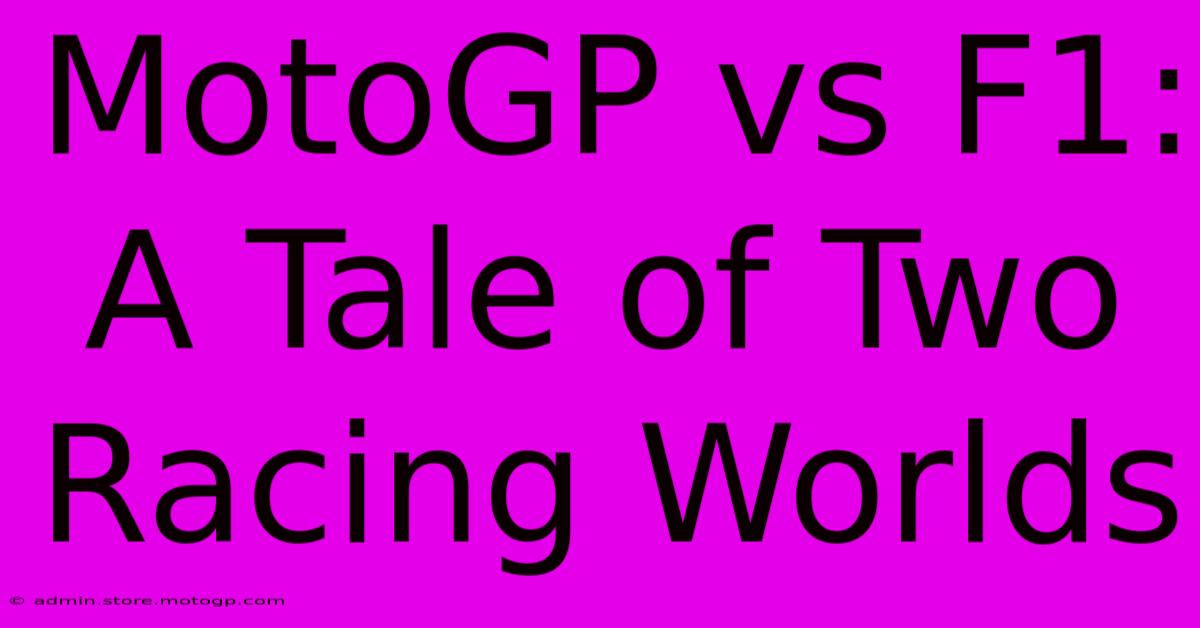MotoGP Vs F1: A Tale Of Two Racing Worlds

Table of Contents
MotoGP vs F1: A Tale of Two Racing Worlds
For motorsport enthusiasts, the roar of engines and the thrill of high-speed competition are irresistible. But within this world, two giants stand apart: MotoGP and Formula 1. While both offer exhilarating racing spectacles, they are vastly different beasts, each possessing unique characteristics that define their appeal. This article delves into the key distinctions between these titans of motorsport, exploring their technical aspects, racing styles, and overall cultural impact.
The Machines: Two-Wheeled Fury vs Four-Wheeled Power
The most immediate difference lies in the vehicles themselves. Formula 1 cars are technologically advanced marvels of engineering, boasting sophisticated aerodynamics, hybrid power units, and advanced electronics. They are the pinnacle of automotive technology, pushing the boundaries of speed and efficiency on four wheels. MotoGP bikes, on the other hand, are lean, mean, two-wheeled machines that demand incredible skill and balance. Their raw power and agility, combined with the inherent instability of two wheels, make for a spectacle of breathtaking skill and control. The sheer power-to-weight ratio of a MotoGP bike is astounding, and the level of rider input required is far greater than in F1.
Key Differences in Technology:
- Engine: F1 utilizes complex hybrid power units, combining internal combustion engines with electric motors for increased efficiency and power delivery. MotoGP bikes typically feature powerful, screaming inline four-cylinder engines.
- Aerodynamics: F1 cars rely heavily on sophisticated aerodynamics for downforce and stability at high speeds. MotoGP bikes use aerodynamic aids to a lesser extent, focusing more on rider skill and machine agility.
- Tyres: Both use specialized racing tyres, but the challenges are distinct. F1 tyres degrade rapidly depending on compounds and track temperature. MotoGP tyres are subjected to immense stresses from lean angles and acceleration.
- Driver/Rider Input: F1 drivers largely manage car setup through electronic aids. MotoGP riders must exert immense physical control to maintain balance and navigate the bike through corners.
The Racing: Style and Strategy
The racing styles in F1 and MotoGP are fundamentally different. F1 races are characterized by strategic pit stops, tire management, and aerodynamic battles for overtaking. Overtaking often relies on exploiting superior car performance or DRS zones. MotoGP races, conversely, are often thrilling battles for position, with riders constantly pushing the limits of adhesion and bravery. Overtaking is a more daring and risky maneuver, requiring precise timing and impeccable skill. The close proximity of riders also makes for intense battles and spectacular moments.
Strategic Variations:
- Overtaking: F1 emphasizes strategic overtaking, while MotoGP relies more on rider skill and daring maneuvers.
- Pit Stops: F1 incorporates strategic pit stops for tire changes and adjustments. MotoGP pit stops are infrequent and focus on quick tire changes.
- Race Length: F1 races are typically longer, allowing for greater strategic depth. MotoGP races are shorter but equally demanding.
The Culture: A Global Phenomenon
Both MotoGP and F1 enjoy massive global followings, yet their fanbases have distinct characteristics. F1's allure often stems from its technological sophistication, glamour, and the global appeal of its teams and drivers. It's a sport that often attracts a more affluent and sophisticated audience. MotoGP's fanbase tends to be more passionate and deeply engaged with the riders themselves, appreciating the raw talent and risk involved. The closer proximity to the riders, the visceral experience of the sound, and the intense battles build a strong sense of community amongst MotoGP fans.
Conclusion: Two Sides of the Same Coin
Ultimately, the choice between MotoGP and F1 often comes down to personal preference. While both offer incredible racing and technological marvels, their approaches to the sport are fundamentally different. F1 represents the pinnacle of automotive engineering and strategic racing, while MotoGP showcases raw human skill, courage, and a thrilling spectacle of two-wheeled combat. Both are deserving of their global recognition and continue to captivate millions of fans worldwide.

Thank you for visiting our website wich cover about MotoGP Vs F1: A Tale Of Two Racing Worlds. We hope the information provided has been useful to you. Feel free to contact us if you have any questions or need further assistance. See you next time and dont miss to bookmark.
Featured Posts
-
Club Si Austin F1 The Ultimate Fan Destination
Feb 20, 2025
-
Moto Gp Announcers Their Expert Predictions And Analysis
Feb 20, 2025
-
Motorcycle Racing The Environmental Impact
Feb 20, 2025
-
Beyond The Helmet F1 And Moto Gp Rider Comparison
Feb 20, 2025
-
The Downforce Dilemma Moto Gp Aerodynamics Explained
Feb 20, 2025
